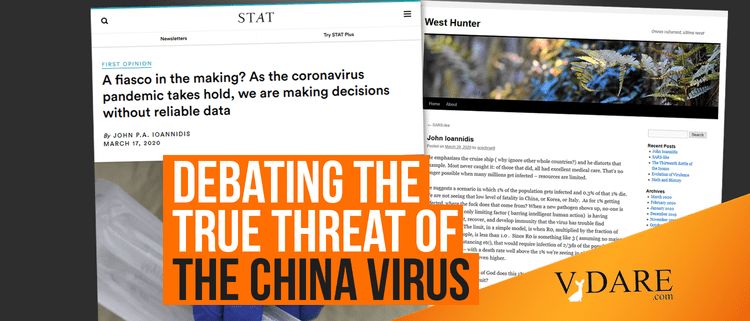


By Steve Sailer
03/20/2020
At West Hunter, Gregory Cochran responds to Stanford professor John Ioannidis’s article downplaying the potential scale of the pandemic:
John Ioannidis
Posted on March 20, 2020 by gcochran9He emphasizes the cruise ship (why ignore other whole countries?) and he distorts that example. Most never caught it: of those that did, all had excellent medical care. That’s no longer possible when many millions get infected — resources are limited.
He suggests a scenario in which 1% of the population gets infected and 0.3% of that 1% die.
We are not seeing that low level of fatality in China, or Korea, or Italy. As for 1% getting infected, where the fuck does that come from? When a new pathogen shows up, no-one is immune, and the only limiting factor (barring intelligent human action) is having enough contract it, recover, and develop immunity that the virus has trouble find vulnerable hosts. The limit, in a simple model, is when R0, multiplied by the fraction of never-infected people, is less than 1.0 . Since R0 is something like 3 (assuming no major efforts at social distancing etc), that would require infection of 2/3ds of the population of the United States — with a death rate well above the 1% we’re seeing in places like South Korea. More like 4%, or even higher.
Again, where in the name of God does this 1% come from? Is Wuflu supposed to quit because he’s caught his limit?
The Spanish flu had an R0 around 2.0. There had been an antigenically related flu around 1890, so older adults were less vulnerable. The percentage infected ranged up to 50% — which, again, is approximately the limit predicted by the value of R0.
When a pathogen is NOT novel, sure, you can have lower fractions of people vulnerable, because many people are already immune, and the fraction infected can be low. If it depends upon some regionally varying vector, like mosquitoes, sure, it doesn’t have to sweep across the whole country. If its R0 is only greater than 1.0 in some subpopulations, as was the case with HIV, it may spread only in those subpopulations.
But Wuflu IS novel, and does NOT depend upon a vector. The vulnerable subpopulation is those that breathe.
So, the surprise-free prediction is that it hits > 50% of the population –
Unless we stop it.